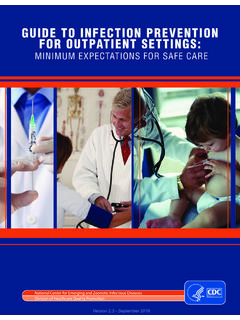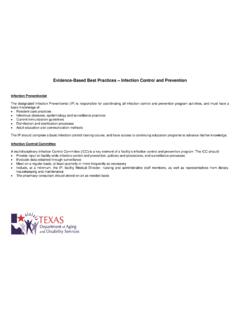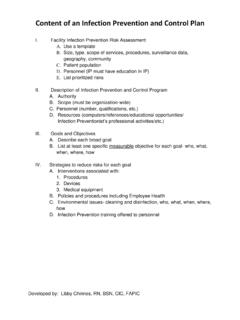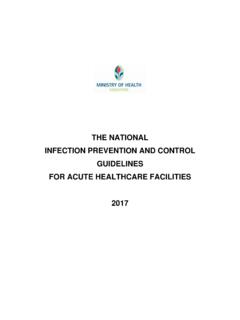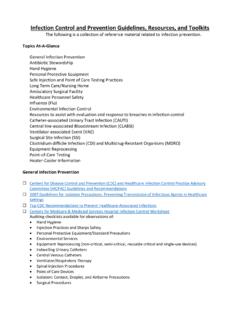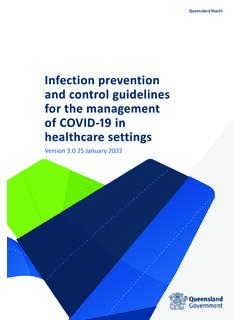Transcription of Infection Prevention and Control Assessment Tool for ...
1 V2-3 Infection Prevention and Control Assessment Tool for Outpatient Settings This tool is intended to assist in the Assessment of Infection Control programs and practices in outpatient settings. In order to complete the Assessment , direct observation of Infection Control practices will be necessary. To facilitate the Assessment , health departments are encouraged to share this tool with facilities in advance of their visit. Please note, Not Applicable should only be checked if the element or domain is not applicable to the types of services provided by the facility ( , the facility never performs point-of -care testing, controlled substances are never kept at the facility).
2 If a particular service is provided by the facility but is unable to be observed during the visit ( , no injections were prepared or administered during the visit) that section should still be completed by interviewing relevant personnel about their practices. Overview Section 1: Facility Demographics Section 2: Infection Control Program and Infrastructure Section 3: Direct Observation of Facility Practices Section 4: Infection Control Guidelines and Other Resources Infection Control Domains for Gap Assessment I. Infection Control Program and Infrastructure II. Infection Control Training and Competency III. Healthcare Personnel Safety IV. Surveillance and Disease Reporting Hand Hygiene Personal Protective Equipment (PPE) Injection Safety (if applicable) Respiratory Hygiene/Cough Etiquette Point-of -Care Testing (if applicable) Environmental Cleaning Device Reprocessing XII. Sterilization of Reusable Devices (if applicable) XIII.
3 High-level Disinfection of Reusable Devices (if applicable) VERSION SEPTEMBER 2016 1 DEPARTMENT OF HEALTH & HUMAN SERVICES Centers for Disease Control and Prevention Section 1: Facility Demographics Facility Name (for health department use only) NHSN Facility Organization ID (for health department use only) State-assigned Unique ID Date of Assessment Type of Assessment On-site Other (specify): Rationale for Assessment (Select all that apply) Outbreak Input from accrediting organization or state survey agency Other (specify): Is the facility licensed by the state?
4 Yes No Is the facility certified by the Centers for Medicare & Medicaid Services (CMS)? Yes No Is the facility accredited? Yes No If yes, list the accreditation organization: Accreditation Association for Ambulatory Health Care (AAAHC) American Association for Accreditation of Ambulatory Surgery Facilities (AAAASF) American Osteopathic Association (AOA) The Joint Commission (TJC) Other (specify): Is the facility affiliated with a hospital? Yes (specify for health department use only): No Which procedures are performed by the facility? Select all that apply. Chemotherapy Endoscopy Ear/Nose/Throat Imaging (MRI/CT) Immunizations OB/Gyn Ophthalmologic Orthopedic Pain remediation Plastic/reconstructive Podiatry Other (specify): What is the primary procedure-type performed by the facility? Select only one. Chemotherapy Endoscopy Ear/Nose/Throat Imaging (MRI/CT) Immunizations OB/Gyn Ophthalmologic Orthopedic Pain remediation Plastic/reconstructive Podiatry Other (specify): How many physicians work at the facility?
5 What is the average number of patients seen per week? VERSION SEPTEMBER 2016 2 DEPARTMENT OF HEALTH & HUMAN SERVICES Centers for Disease Control and Prevention Section 2: Infection Control Program and Infrastructure I. Infection Control Program and Infrastructure Elements to be assessed Assessment Notes/Areas for Improvement A. Written Infection Prevention policies and procedures are available, current, and based on evidence-based guidelines ( , CDC/HICPAC), regulations, or standards. Note: Policies and procedures should be appropriate for the services provided by the facility and should extend beyond OSHA bloodborne pathogens training Yes No B. Infection Prevention policies and procedures are re-assessed at least annually or according to state or federal requirements, and updated if appropriate.
6 Yes No C. At least one individual trained in Infection Prevention is employed by or regularly available ( , by contract) to manage the facility s Infection Control program. Note: Examples of training may include: Successful completion of initial and/or recertification exams developed by the Certification Board for Infection Control & Epidemiology; participation in Infection Control courses organized by the state or recognized professional societies ( , APIC, SHEA). Yes No D. Facility has system for early detection and management of potentially infectious persons at initial points of patient encounter. Note: System may include taking a travel and occupational history, as appropriate, and elements described under respiratory hygiene/cough etiquette. Yes No II. Infection Control Training and Competency Elements to be assessed Assessment Notes/Areas for Improvement A. Facility has a competency-based training program that provides job-specific training on Infection Prevention policies and procedures to healthcare personnel.
7 Note: This includes those employed by outside agencies and available by contract or on a volunteer basis to the facility. See sections below for more specific Assessment of training related to: hand hygiene, personal protective equipment (PPE), injection safety, environmental cleaning, point-of-care testing, and device reprocessing Yes No VERSION SEPTEMBER 2016 3 DEPARTMENT OF HEALTH & HUMAN SERVICES Centers for Disease Control and Prevention III. Healthcare Personnel Safety Elements to be assessed Assessment Notes/Areas for Improvement A. Facility has an exposure Control plan that is tailored to the specific requirements of the facility ( , addresses potential hazards posed by specific services provided by the facility). Note: A model template, which includes a guide for creating an exposure Control plan that meets the requirements of the OSHA Bloodborne Pathogens Standard is available at: Yes No B.
8 HCP for whom contact with blood or other potentially infectious material is anticipated are trained on the OSHA bloodborne pathogens standard upon hire and at least annually. Yes No C. Following an exposure event, post-exposure evaluation and follow-up, including prophylaxis as appropriate, are available at no cost to employee and are supervised by a licensed healthcare professional. Note: An exposure incident refers to a specific eye, mouth, other mucous membrane, non-intact skin, or parenteral contact with blood or other potentially infectious materials that results from the performance of an individual s duties. Yes No D. Facility tracks HCP exposure events and evaluates event data and develops/implements corrective action plans to reduce incidence of such events. Yes No E. Facility follows recommendations of the Advisory Committee on Immunization Practices (ACIP) for immunization of HCP, including offering Hepatitis B and influenza vaccination.
9 Note: Immunization of Health-Care Personnel: Recommendations of the ACIP available at: Yes No F. All HCP receive baseline tuberculosis (TB) screening prior to placement; HCP receive repeat testing, if appropriate, based on the facility-level risk Assessment . Note: For more information, facilities should refer to the Guidelines for Preventing the Transmission of Mycobacterium tuberculosis in Health-Care Settings, 2005 available at: ?s_cid=rr5417a1_e Yes No G. If respirators are used, the facility has a respiratory protection program that details required worksite-specific procedures and elements for required respirator use, including provision of medical clearance, training, and fit testing as appropriate. Yes No Not Applicable H. Facility has well-defined policies concerning contact of personnel with patients when personnel have potentially transmissible conditions. These policies include: i. Work-exclusion policies that encourage reporting of illnesses and do not penalize with loss of wages, benefits, or job status.
10 Ii. Education of personnel on prompt reporting of illness to supervisor. Yes No Yes No Yes No VERSION SEPTEMBER 2016 4 DEPARTMENT OF HEALTH & HUMAN SERVICES Centers for Disease Control and Prevention IV. Surveillance and Disease Reporting Elements to be assessed Assessment Notes/Areas for Improvement A. An updated list of diseases reportable to the public health authority is readily available to all personnel. Yes No B. Facility can demonstrate knowledge of and compliance with mandatory reporting requirements for notifiable diseases, healthcare associated infections (as appropriate), and for potential outbreaks.










